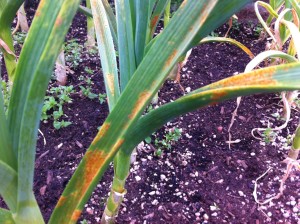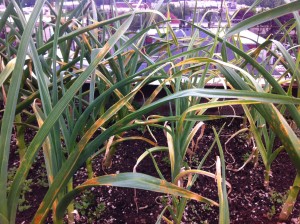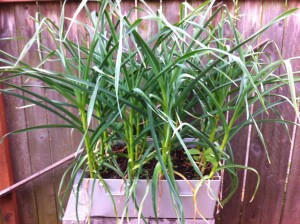This year I have decided to take on garlic rust, a very formidable foe that levelled my rooftop garlic crop completely last year. Funny thing about these diseases, they can have the most lyrical Latin names. Garlic rust is alternatively called Puccinia allii and Puccinia porri, either of which I could imagine coming off the lips of Pavarotti at La Scala. Well, the poetry all vanishes when you listen to the description of the disease from a website like the University of California’s Integrated Pest Management Program (http://www.ipm.ucdavis.edu/PMG/r584101211.html). It says that garlic rust causes “dull orange, oval-shaped pustules to develop on the leaf blades” and then says that “reddish airborne urediospores are copiously produced within the lesions.” Anybody see anything operatic now? Not with a libretto full of pustules and lesions.
Witness the awful, orange pustules of garlic rust!
So last year this garlic rust blasted through our rooftop garlic crop, causing leaves to yellow fast and the whole garlic stalk to just wither, leaving a bulb about the size of the initial, fall-planted clove. In other words, nothing gained after 9 months of growth. Needless to say, I was a little caught in my tracks by the severity of the attack, and by the time I got around to researching, it was too late. I did get some helpful information from the popular garden blog Garden Betty (http://www.gardenbetty.com/2011/07/grrr-garlic-rust-and-how-to-deal/) , but she seems entirely too sanguine about this disease. Whereas even her infected plants seemed to produce something, mine just withered and pretty much gave up the ghost.
This is what fighting back looks like. Garlic is definitely affected, but still standing and, hopefully, clove-forming.
This year I saw the symptoms coming early and, less stunned than last year, decided to punch back. Luckily we’ve had a warm spring, with many periods of sunny weather. I used each of those sun breaks to level a blast of dilute neem oil at the dreaded pustules. Neem, a fast-growing tree in the mahogany family found in India, has many beneficial gardening uses, not the least of which is serving as a broad spectrum organic antifungal. My experience is that it really did hold the rust at bay, which is not to say that it really reversed anything. My garlic has grown, but the rust has continued to encroach until such time as I was able to re-neem. I have no doubt, however, that without the neem, those nascent cloves of garlic would have been lost, given the ferocity of the rust as witnessed last season, and I shudder to think that if it had been a more typical, rainy spring, I probably wouldn’t have been able to spray as frequently, with the equally probably result of premature garlic death.
More than once this season, I contemplated whether so much spraying was worth it. Since I haven’t yet seen the cloves I am hoping for, I still can’t weigh in fully on that. Are there any other alternatives? Many websites recommend a strict allium diet for the garden – no onion family members at all for three years (no leeks, no chives, no bunching onions, no bulbing onions, and, of course, no garlic), because apparently garlic rust can take lodging in other related species, even though it may not produce symptoms. That would be a hard discipline to subject oneself to, and yet I may find myself hemmed in thus by the pernicious, persistent rust. Fortunately there are other gardens that I tend where the spores have not fallen or blown, and where it is still possible to grow a spray-free crop. But for how long….who knows?
My home garden garlic, where garlic rust has not yet raised its pustule-filled head nor gnashed its lesionous teeth! May it stay away!



